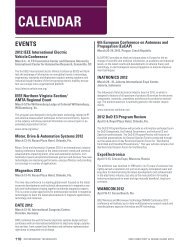2011 EMC Directory & Design Guide - Interference Technology
2011 EMC Directory & Design Guide - Interference Technology
2011 EMC Directory & Design Guide - Interference Technology
Create successful ePaper yourself
Turn your PDF publications into a flip-book with our unique Google optimized e-Paper software.
testing & test equipment<br />
N e w <strong>EMC</strong> Requir e m e n t s F o r C o mm e r c i a l Av i o nic s<br />
21: the Anechoic Chamber method, and<br />
the Reverberation Chamber method.<br />
The Anechoic Chamber method<br />
requires a chamber lined with RF<br />
absorber, and the minimum performance<br />
of the absorber is specified. The<br />
measurement antenna distance is 1<br />
meter, and multiple antenna positions<br />
are required when the beamwidth of<br />
the antenna does not totally cover<br />
the system. If the EUT has apertures,<br />
connectors, seams, or other points of<br />
penetration in the EUT enclosure, all<br />
of these must be directly exposed to the<br />
test antenna, requiring multiple EUT<br />
positions during testing.<br />
The second method uses a Reverberation<br />
Chamber, which requires a Field<br />
Uniformity Validation from Section<br />
20. EUT Loading is measured after the<br />
EUT is installed in the chamber, and<br />
this data is used as a correction factor<br />
for the radiated emissions measurement.<br />
A minimum of 200 sweeps of the<br />
analyzer or measurement receiver is<br />
required over one rotation of the tuner,<br />
for each measured frequency range.<br />
Equipment categories<br />
There are 6 Equipment Categories (B,<br />
L, M, H, P, and Q) that indicate the<br />
location of the equipment and the<br />
separation between the equipment and<br />
aircraft antennas. In general, the closer<br />
the equipment is to an aircraft antenna,<br />
and the more it approaches a "direct<br />
view" of an aircraft antenna, the tighter<br />
the emissions limits.<br />
What’s new for DO-160G?<br />
• Users <strong>Guide</strong>.<br />
• A new limit category has been added<br />
- Category Q - to provide added protection<br />
for VHF and GPS receivers,<br />
but without the Conducted Emissions<br />
“HF notch” used in Category P<br />
(see Figure 1 and Figure 2).<br />
• Change in the frequency for the<br />
bandwidth step from 100 kHz to 1<br />
MHz. Previous versions had this step<br />
at 1 GHz. DO-160G has the step at<br />
960 MHz.<br />
• Removal of the option to use a 10 kHz<br />
bandwidth to measure in the notches<br />
above 960 MHz, and instead, a note<br />
that a high-gain pre-amplifier may<br />
(will) be required.<br />
SECTION 22: LIGHTNING<br />
INDUCED TRANSIENT<br />
SUSCEPTIBILITY<br />
These tests determine whether the<br />
EUT can operate as specified during<br />
and/or after various lightning induced<br />
transient waveforms are injected into<br />
connector pins, interconnecting cables,<br />
and power leads using pin injection,<br />
and/or cable bundle tests. The pin<br />
injection method is normally used to<br />
show damage tolerance, while the cable<br />
bundle tests are normally used to show<br />
upset tolerance.<br />
Change 3 to DO-160D, issued December<br />
5, 2002, was a major revision<br />
of Section 22, primarily to add procedures,<br />
waveforms, and test levels for<br />
Multiple Burst and Multiple Stroke<br />
Cable Bundle test methods. New Waveform<br />
Set designators (G through K)<br />
were also added to cover the Multiple<br />
Burst and Multiple Stroke tests.<br />
Pin injection<br />
During pin injection testing, the EUT is<br />
normally powered, so that the circuits<br />
being tested are biased as they would<br />
be in normal operation. The test level<br />
is defined as an open circuit voltage<br />
(Voc) with a specified source impedance<br />
from the generator. For example,<br />
waveform 3, test level 2 specifies Voc as<br />
250 volts, with a short circuit current<br />
(Isc) of 10 amps. The ratio of Voc to Isc<br />
yields a generator source impedance<br />
requirement of 25 ohms. The generator<br />
is adjusted to produce waveform 3<br />
with these specified characteristics, and<br />
the transient waveform is then applied<br />
directly to the interface pins. After the<br />
pins have been tested, the EUT is evaluated<br />
to determine if its performance has<br />
been degraded.<br />
Cable bundle tests<br />
Cable Bundle Tests are performed using<br />
either Cable Induction or Ground Injection<br />
to couple the transient waveforms<br />
into the interconnecting cable bundles<br />
and power leads.<br />
The cable induction test method<br />
uses an injection probe to induce the<br />
transient waveforms into interconnecting<br />
cables and power leads. The ground<br />
injection method is very similar to the<br />
cable induction method, except that the<br />
transient waveform is applied between<br />
the EUT case and the ground plane.<br />
The EUT is isolated from the ground<br />
plane by lifting all local grounds and<br />
returns, and insulating the case from<br />
the ground plane, which forces the<br />
injected transient into the cable shields<br />
and any other return paths back to the<br />
ground plane.<br />
A Line Impedance Stabilization Network<br />
(LISN) must be inserted in series<br />
with each power lead and ungrounded<br />
power return lead, with a 10 uF capacitor<br />
connected between the power<br />
input of the LISN and the ground plane<br />
for AC powered equipment, or with a<br />
33,000 uF capacitor connected across<br />
the power inputs of the LISNs for DC<br />
powered equipment. Unless otherwise<br />
specified, interconnecting cables shall<br />
be at least 3.3 meters in length, and<br />
power leads will be no more than 1<br />
meter in length for these tests.<br />
For each waveform, either a voltage<br />
or current test level is given, along with<br />
a current or voltage limit. For example,<br />
waveform 2, test level 3, specifies a voltage<br />
test level (VT) of 300 volts, and current<br />
limit (IL) of 600 amps. This means<br />
that during the test, the generator level<br />
is increased until the peak voltage measured<br />
on a single turn monitor loop<br />
placed thru the injection probe reaches<br />
300 volts, or the monitored induced<br />
current in the cable or lead reaches the<br />
600 amp limit.<br />
Cable Bundle tests may be performed<br />
using the Single Stroke method<br />
only, or using a combination of the<br />
Single Stroke, Multiple Stroke, and<br />
Multiple Burst methods.<br />
The Single Stroke test method is designed<br />
to represent the internal aircraft<br />
wiring response to the most severe external<br />
aircraft lightning strike. A single<br />
occurrence (stroke) of the specified test<br />
waveform is applied to the cable bundle<br />
or wire under test, and repeated for a<br />
total of 10 applications in each polarity.<br />
The Multiple Stroke test method<br />
is designed to represent the induced<br />
effects to internal aircraft wiring in<br />
response to an external aircraft lightning<br />
strike that is composed of a first<br />
return stroke immediately followed by<br />
multiple return strokes (see Figure 5).<br />
The Multiple Burst test method is<br />
64 interference technology emc <strong>Directory</strong> & design guide <strong>2011</strong>




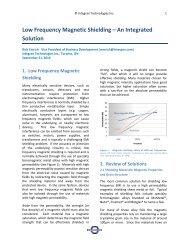

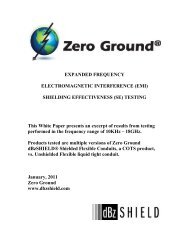
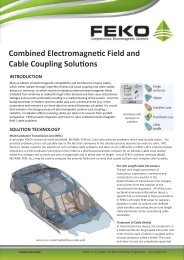

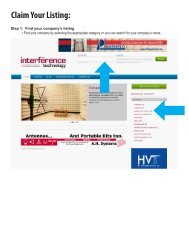

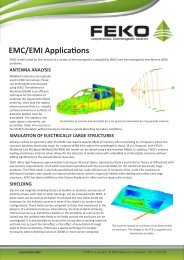
![[ thursday ] morning sessions 8:30 am-noon - Interference Technology](https://img.yumpu.com/23176841/1/190x247/-thursday-morning-sessions-830-am-noon-interference-technology.jpg?quality=85)
